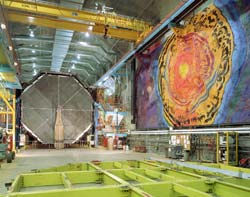MINOS detector ready to take first data

Technicians assembled each detector plane on a strongback (foreground). The whole plane was then lifted by crane and transported to its final position. It took less than two days to assemble and erect a single plane. <br>
Today, (August 14th), sees the start of data collection on the Main Injector Neutrino Oscillation Search (MINOS) detector, situated in the Soudan iron mine, Minnesota, USA. UK particle physicists, working within an international collaboration, will use the MINOS detector to investigate the phenomenon of neutrino mass – a puzzle that goes to the heart of our understanding of the Universe.
Neutrinos are pointlike, abundant particles with very little mass. They exist in three types or ‘flavours’ and recent experiments (including those at SNO – the Sudbury Neutrino Observatory) have demonstrated that neutrinos are capable of oscillating between these flavours (electron, tau and muon). This can only happen if one or more of the neutrino flavours does have mass, in contradiction to the Standard Model of particle physics.
The MINOS detector will start measurements of cosmic ray showers penetrating the Earth. It is situated in the Soudan Mine, Minnesota. The 30-metre-long detector consists of 486 massive octagonal planes, lined up like the slices of a loaf of bread. Each plane consists of a sheet of steel about 8 metres high and 2 ½ cm thick, covered on one side with a layer of scintillating plastic that emits light when struck by a charged particle.
“MINOS can separate neutrino interactions from their antimatter counterparts – the antineutrinos.” explains UK MINOS spokesperson, Jenny Thomas from University College London. “The data taken now from neutrinos produced in cosmic ray cascades may provide new insight into why the Universe is made of more matter than antimatter. At least, for the first time we will be able to compare the characteristics of neutrinos and anti-neutrinos coming from the atmosphere.”
However, MINOS has more ambitious plans in place for August 2004. Whilst most experiments like SNO measure neutrinos coming from the Sun, when complete, MINOS will instead study a beam of man-made neutrinos, all of the same type or ‘flavour’ – the muon neutrino flavour. This beam will be created at Fermi National Accelerator Laboratory (Fermilab) and sent straight through the Earth to Soudan – a distance of 735 kilometres. No tunnel is needed because neutrinos interact so rarely with matter. A detector is currently being built just outside Fermilab, known as the ‘near’ detector, similar but smaller than the now operational MINOS detector, known as the ‘far’ detector. The ‘near’ detector will act as a control, studying the beam as it leaves Fermilab, then the results will be compared with those from the ‘far’ detector to see if the neutrinos have oscillated into electron or tau neutrinos during their journey.
A million million neutrinos will be created at Fermilab each year, but only 1,500 will interact with the nucleus of an atom in the far detector and generate a signal; the others will pass straight through.
“The realisation that neutrinos oscillate, first demonstrated by the Super Kamiokande experiment in Japan, has been one of the biggest surprises to emerge in particle physics since the inception of the Standard Model more than 30 years ago.” says Jenny Thomas. “The MINOS experiment will measure the oscillation parameters of these neutrinos to an unprecedented accuracy of a few percent; an amazing feat considering neutrinos can usually pass directly through the Earth without interacting at all and that their inferred masses are estimated to be less than 1eV. (The weight ratio of a neutrino to a 1kg bag of sugar is the same as the ratio of a grain of sand to the weight of the earth!). The parameter measurement will open up an entire new field of particle physics, to understand what effect on the universe this tiny neutrino mass has.”
Within two years of turning on the neutrino beam, MINOS should produce an unequivocal measurement of the oscillation of muon neutrinos with none of the uncertainties associated with the atmospheric or solar neutrino source. If indeed the findings are positive, then a new era in particle physics will begin. Theorists will have to incorporate massive neutrinos into the Standard Model, which will have exciting implications. Furthermore cosmologists will have a strong candidate for the ‘missing mass’ of the Universe (which dynamical gravitational measurements show must exist). The experimental side will be just as exciting as we plan new experiments to measure precisely how the different neutrinos change their flavour.
Media Contact
All latest news from the category: Physics and Astronomy
This area deals with the fundamental laws and building blocks of nature and how they interact, the properties and the behavior of matter, and research into space and time and their structures.
innovations-report provides in-depth reports and articles on subjects such as astrophysics, laser technologies, nuclear, quantum, particle and solid-state physics, nanotechnologies, planetary research and findings (Mars, Venus) and developments related to the Hubble Telescope.
Newest articles

Properties of new materials for microchips
… can now be measured well. Reseachers of Delft University of Technology demonstrated measuring performance properties of ultrathin silicon membranes. Making ever smaller and more powerful chips requires new ultrathin…

Floating solar’s potential
… to support sustainable development by addressing climate, water, and energy goals holistically. A new study published this week in Nature Energy raises the potential for floating solar photovoltaics (FPV)…

Skyrmions move at record speeds
… a step towards the computing of the future. An international research team led by scientists from the CNRS1 has discovered that the magnetic nanobubbles2 known as skyrmions can be…





















